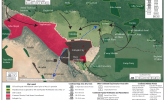 |
 |
Fallujah Control of Terrain Map: May 31, 2016
The operation to retake Fallujah has advanced towards the city limits since ISW’s May 26 Fallujah map, as joint forces from the Iraqi Security Forces (ISF), Popular Mobilization, and Sunni tribal fighters close in on a multiple-axis assault to encircle the city. The ISF and Popular Mobilization continue to recapture terrain north of Fallujah, including al-Sajar, and consolidate holdings around Garma District, which was recaptured on May 23. Popular Mobilization Deputy Chairman Abu Mahdi al-Muhandis, a U.S. designated terrorist and Iranian proxy leader, arrived in Arimiyah, north of Saqlawiyah, on May 31, in order to oversee operations on the western axis, as the ISF and Popular Mobilization work to uproot ISIS from the area. Joint forces retook Saqlawiyah’s city center on May 30, but they will need to secure the area before moving into Fallujah city. The ISF entered Fallujah’s city limits on May 30, when forces from the Counter Terrorism Service (CTS) reached Hayy al-Shuhada, the southernmost neighborhood in Fallujah, where they face stiff ISIS resistance against moving into the city.
Iranian-backed Iraqi Shi’a militias maintain a steady presence in northern Fallujah, where reports have surfaced of abuses against Sunni populations. Several local sources claim that Popular Mobilization fighters destroyed the Great Mosque in Garma while chanting sectarian slogans and vowing to kill residents. Sources claimed that militias prevented the Sunni Waqf head from entering Garma to organize Friday prayers, have looted homes and factories around Garma, and arrested civilians. A notable tribal sheikh in Garma claimed that Popular Mobilization militants kidnapped 73 men from Garma District andexecuted 17 of them on charges of belonging to ISIS. Prime Minister Haidar al-Abadi, however, criticized media outlets for distorting the truth and inciting sectarianism through false reporting on events in Fallujah.
Shi’a militia abuses against the Sunni population might further radicalize Iraq’s Sunni population. Fallujah’s population has suffered under ISIS’s rule for over two years, but residents may be inclined to remain complicit or even identify with ISIS’s extreme sectarian ideology if they feel terrorized by Shi’a militias. Joint forces have opened several corridors for safe passage out of the city that lead primarily to recaptured terrain to the north and south of Fallujah. However, the U.N. has reported that only 3,700 civilians out of the estimated 50,000 remaining in the city have fled from Fallujah over the past week. ISIS has prevented civilians from leaving the area, by force and by requiring a steep payment to leave. Nevertheless, historically anti-government Sunni residents, some of whom were complicit when ISIS first took the city in January 2014, may be inclined to support ISIS rather than seek aid from Shi’a militias. The mindset that Iraqi Sunnis are better off under extremist ideology than in a Shi’a-driven government can perpetuate the Salafi-jihadi movement in Iraq. Until Iraq can guarantee Sunni representation and security, extremist groups will continue to find shelter amongst Iraq’s Sunni population.
